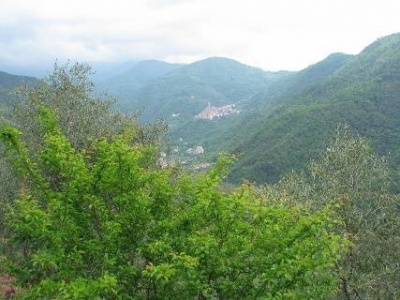Madonna di Campagna
At an altitude of just under 500 meters the area is only a little over 10 minutes from down town Pigna and is home to a large number of plots of lands and several country houses, some of which are permanently inhabited with quite a few being second homes whilst many double as tool sheds and storage (plus numerous derelict buildings subjected to the charming decay from years of abandonment). In this and similar areas in the highlands around Pigna, the locals have additional plots of production land as remote kitchen gardens and for resale of wonderful fresh organic growth of herbs, salads and vegetables. Enjoy the gallery below with a selection of views from and on Madonna di Campagna:
From the house and the terrace you will never tire watching the stunning views over the mountains towards the south. The two photos below show Monte Bignone (1299m) to the left and Monte Caggio (1090m) to the right. The Mediterranean ocean is behind the farthest ridge (less than 20 km straight line) with San Remo below Monte Bignone and Bordighera below Monte Caggio:






Changing light incidents reveal completely new details, and together with clouds moving it gives the viewer a beautiful and fascinating panorama, which almost has therapeutic qualities – don’t count on much reading in your book if this scenery meets your eyes! In the evening, lights from the small town Perinaldo can be seen out on the horizon at the farthest ridge (right of centre). The city Baiardo is hidden behind the ridge on the left and the city Apricale lies hidden in the valley before Perinaldo.
And a rare show of thunder and lightning on the eastern hemisphere….

The king of local produce is olive oil from the common Ligurian olive tree variety: Taggiasca. The virgin oil (they only do virgin!) is praised for its low acidity as compared to olive growth in more southern and hot climates. Moreover, some vegetables are grown on a large scale, not forgetting the famous white Pigna beans (included in the Italian Slow Food Guide). Last, but not least, there has previously been a major production of flowers, plants, especially ornamental foliage (eucalyptus, ruscus and mimosa) in numerous small and large nurseries.
In the “central” part of Madonna di Campagna, you will find a little church, where an annual mass (harvest worship) is officiated by the local vicar every year 16 July. Usually people bring homemade snacks or finger food plus wine for a social gathering outside the church after mass.


Many local Pigna-villagers go up to their properties almost on a daily basis in order to take care of their land and often also to pick a selection of fresh organic produce for lunch or dinner. You will find they’re very hospitable and helpful – because they themselves love the wonderful nature around the area anyone coming by and sharing that feeling is embraced with much sympathy and tolerance.
